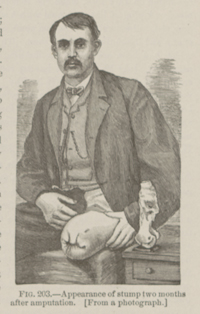Title: Bowen, Charles M.
Source text: The Medical and Surgical History of the War of the Rebellion. (1861-65.), Part 3, Volume 2 (Washington, DC: Government Printing Office, 1883), 311.
Civil War Washington ID: med.d2e13945
TEI/XML: med.d2e13945.xml
CASE 486.—Private Charles M. Bowen,¹ Co. A, 27th Indiana, aged 19 years, was wounded at Antietam, September 17, 1862. He was taken to Frederick and admitted to No. 1 hospital on September 24th. Acting Assistant Surgeon J. C. Shimer records the following: "A conoidal ball had entered the outer aspect of the left thigh about five inches above the knee, fractured the femur, and passed out directly opposite. Buck's apparatus was applied. On October 19th, considerable amount of callus had been thrown out, and there was some union; his appetite and general condition were good. October 23d, a deep but circumscribed abscess on the outer side of middle third of thigh was opened and evacuated. 30th, both the wounds of entrance and exit were enlarged to evacuate pus more freely. December 5th, he has improved greatly; passive motion has been employed to overcome stiffness of the knee." On March 18, 1863, he was able to walk with the aid of crutches, and the wounds had nearly healed. A slight attack of erysipelas yielded readily to treatment. May 21st, the wound took on a gangrenous condition, for which strong nitric acid was applied. On June 15th, he was transferred to Baltimore. The wounds looked healthy and his general condition was excellent. He entered the Jarvis Hospital on the 16th, and was discharged September 7, 1863. The femur had only partially united; the sciatic nerve was injured; his leg was partially and his foot entirely paralysed. He received a pension, and was employed as a clerk in the Interior Department. Owing to a recurrence of abscesses he entered the Providence Hospital, Washington, in the autumn of 1867, and, on November 11th, the limb was amputated in the middle third by Dr. D. W. Bliss, late Surgeon U. S. V. The wound healed well, and a photograph was taken at the Army Medical Museum on January 9, 1868, at which time the stump was firm and healthy. The specimen was contributed to the Museum by the operator, and is No. 4914, Surgical Section. The fragments are considerably overlapped, having undergone unusual disturbance, and the amount of callus exceeds what is necessary for complete union. On March 10, 1871, the patient was a clerk in the Pension Office; the stump was healthy but his general health poor. He died March 17, 1878, of phthisis pulmonalis.
¹ Circular No. 3, Surgeon General's Office, Washington, 1871, p. 205, CASE DLXXXV.
